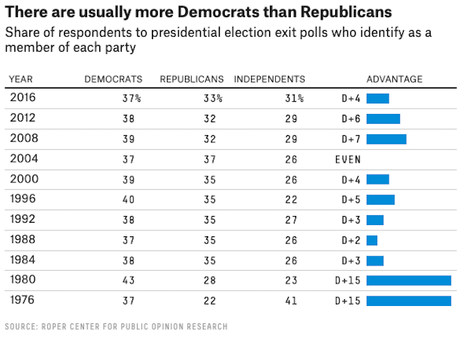
The chart above and the article below are by Nate Silver at fivethirtyeight.com. They show that Donald Trump can't just depend on his base to put him back in the White House in 2020. That's because there are simply more Democrats than Republicans in this country. He will need Independents to vote for him. But those Independents voted against him in 2018, and are likely to do so again in 2020.
Here's part of what Mr. Silver wrote:
This year’s results do serve as a warning to Trump in one important sense, however: His base alone will not be enough to win a second term. Throughout the stretch run of the 2018 midterm campaign, Trump and Republicans highlighted highly charged partisan issues, from the Central American migrant caravan to Brett Kavanaugh’s confirmation to the Supreme Court. And Republican voters did indeed turn out in very high numbers: GOP candidates for the House received more than 50 million votes, more than the roughly 45 million they got in 2010. But it wasn’t enough, or even close to enough. Problem No. 1 is that Republicans lost among swing voters: Independent voters went for Democrats by a 12-point margin, and voters who voted for a third-party candidate in 2016 went to Democrats by 13 points. Trump and Republicans also have Problem No. 2, however: Their base is smaller than the Democratic one. This isn’t quite as much of a disadvantage as it might seem; the Democratic base is less cohesive and therefore harder to govern. Democratic voters are sometimes less likely to turn out, although that wasn’t a problem this year. And because Republican voters are concentrated in rural, agrarian states, the GOP has a big advantage in the Senate.
And arguably in the House of Representatives and the Electoral College — although those advantages may not be as sustainable.
" data-footnote-id="1" style="border: 0px; box-sizing: border-box; font-family: inherit; font-stretch: inherit; font-style: inherit; font-variant-caps: inherit; line-height: inherit; margin: 0px; padding: 0px; position: relative; text-decoration: none; text-rendering: optimizeLegibility; vertical-align: baseline;" href="https://fivethirtyeight.com/features/trumps-base-isnt-enough/#fn-1" class="espn-footnote-link">1 Nonetheless, it does mean that Republicans can’t win the presidency by turning out their base alone, a strategy that sometimes is available to Democrats. (Obama won re-election in 2012 despite losing independents by 5 points because his base was larger.) In the exit polling era, Republicans have never once had an advantage in party identification among voters in presidential years. George W. Bush’s Republicans were able to fight Democrats to a draw in 2004, when party identification was even, but that was the exception rather than the rule. . . . Presidents such as Reagan, Clinton and Obama, who recovered to win re-election after difficult midterms, didn’t do it without making some adjustments. Both Reagan and Clinton took a more explicitly bipartisan approach after their midterm losses. Obama at least acknowledged the scope of his defeat, owning up to his “shellacking” after 2010, although an initially bipartisan tone in 2011 had given way to a more combative approach by 2012. All three presidents also benefited from recovering economies — and although the economy is very strong now, there is arguably more downside than upside for Trump (voters have high expectations, but growth is more likely than not to slow a bit). Trump’s political instincts, as strong as they are in certain ways, may also be miscalibrated. Trump would hate to acknowledge it, but he got most of the breaks in the 2016 election. He ran against a highly unpopular opponent in Clinton and benefited from the Comey letter in the campaign’s final days. He won the Electoral College despite losing the popular vote — an advantage that may or may not carry over to 2020, depending on whether voters in the Midwest are willing to give him the benefit of the doubt again. Meanwhile, this year’s midterms — as well as the various congressional special elections that were contested this year and last year — were fought largely on red turf, especially in the Senate, where Trump may well have helped Republican candidates in states such as Indiana and North Dakota. The Republican play-to-the-base strategy was a disaster in the elections in Virginia in 2017 and in most swing states and suburban congressional districts this year, however. At the least, odds are that Trump needs a course-correction, and it’s anyone’s guess as to whether he’ll be willing to take one. While there’s some speculation that Trump could move in a more bipartisan direction, that hasn’t really been apparent yet in his actions since the midterms, or at least not on a consistent basis. Instead, he’s spent the first fortnight after the midterms firing his attorney general, implying that Democrats were trying to steal elections in Florida, and bragging about how he’d give himself an A-plus rating as president. The next two years will less be a test of Trump’s willpower than one of his dexterity and even his humility — not qualities he’s been known to have in great measure.
